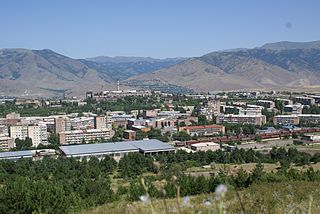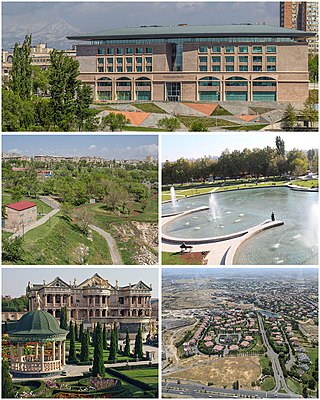
Yerevan is the capital and largest city of Armenia, as well as one of the world's oldest continuously inhabited cities. Situated along the Hrazdan River, Yerevan is the administrative, cultural, and industrial center of the country, as its primate city. It has been the capital since 1918, the fourteenth in the history of Armenia and the seventh located in or around the Ararat Plain. The city also serves as the seat of the Araratian Pontifical Diocese, which is the largest diocese of the Armenian Apostolic Church and one of the oldest dioceses in the world.

Grigor Narekatsi was an Armenian mystical and lyrical poet, monk, and theologian. He is venerated as a saint in the Armenian Apostolic and Catholic Churches and was declared a Doctor of the Church by Pope Francis in 2015.
Education in Armenia is held in particular esteem in Armenian culture. Education developed the fastest out of the social services, while health and welfare services attempted to maintain the basic state-planned structure of the Soviet era, following Armenia's independence in 1991. Today, Armenia is trying to implement a new vision for its higher education system while pursuing the goals of the European Higher Education Area. The Ministry of Education and Science oversees education in the country.

The Mkhitar Heratsi Yerevan State Medical University, is an Armenian medical university located in Yerevan, Armenia.
Nairi was the Akkadian name for a region inhabited by a particular group of tribal principalities in the Armenian Highlands, approximately spanning the area between modern Diyarbakır and Lake Van and the region west of Lake Urmia. Nairi has sometimes been equated with Nihriya, known from Mesopotamian, Hittite, and Urartian sources. However, its co-occurrence with Nihriya within a single text may argue against this.

Alexander Tamanian was a Russian-born Armenian neoclassical architect, well known for his work in the city of Yerevan.

Yerevan Brusov State University of Languages and Social Sciences, is a public university in Yerevan, the capital of Armenia, operating since 1935. It is named after the Russian poet and historian Valery Bryusov since 1962.

Sergey Mergelyan was a Soviet and Armenian mathematician, who made major contributions to the Approximation theory. The modern Complex Approximation Theory is based on Mergelyan's classical work. Corresponding Member of the Academy of Sciences of the Soviet Union, member of NAS ASSR.

Arabkir, is one of the 12 districts of Yerevan, the capital of Armenia. Located to the north of the city centre, Arabkir is bordered by the Davtashen District from the northwest, Ajapnyak District from the west, Kentron District from the south, and Kanaker-Zeytun District from the east. Hrazdan River forms the natural border of the district from the north and the west. At the north, Arabkir has common borders with the community of Kanakeravan of Kotayk Province.

Charentsavan, is a town and urban municipal community in the Kotayk Province of Armenia. It was founded in 1947 as Lusavan, and renamed in 1967 after the poet Yeghishe Charents. According to the 2011 census, the population of Charentsavan is 20,363. Currently, the town has an approximate population of 18,500 as per the 2016 official estimate.

Kanaker-Zeytun is one of the 12 districts of Yerevan, the capital of Armenia, located in the northeastern part of the city. As of the 2022 census, the population of the district is 73,834.

Ajapnyak, is one of the 12 districts of Yerevan, the capital of Armenia. Located to the northwest of the city centre, Ajapnyak has common borders with the districts of Arabkir from the east, Davtashen from the north, Kentron from the southeast, and Malatia-Sebastia from the south. Hrazdan River forms the natural border of the district from the east. Ajapnyak has also common borders with the provinces of Armavir and Aragatsotn from the west, and Kotayk from the north.

Erebuni is one of the 12 districts of Yerevan, the capital of Armenia. It is situated southeast of the city centre where Erebuni Fortress is located. The name of Yerevan itself is derived from ancient Erebuni.

Haybusak University of Yerevan, is a private university in Armenia.

Arakelots Monastery was an Armenian monastery in the historic province of Taron, 11 km south-east of Mush (Muş), in present-day eastern Turkey. According to tradition, Gregory the Illuminator founded the monastery to house relics of several apostles. The monastery was, however, most likely built in the 11th century. During the 12th-13th centuries it was a major center of learning. In the following centuries it was expanded, destroyed and renovated. It remained one of the prominent monasteries of Turkish (Western) Armenia until the Armenian genocide of 1915, when it was attacked and subsequently abandoned. It remained standing until the 1960s when it was reportedly blown up. Today, ruins of the monastery are still visible.
Hakob Sahak Hovakimyan, better known as Hrayr Hovakimyan, is an Armenian doctor and cardiac surgeon who was awarded the title of National Hero of Armenia.












